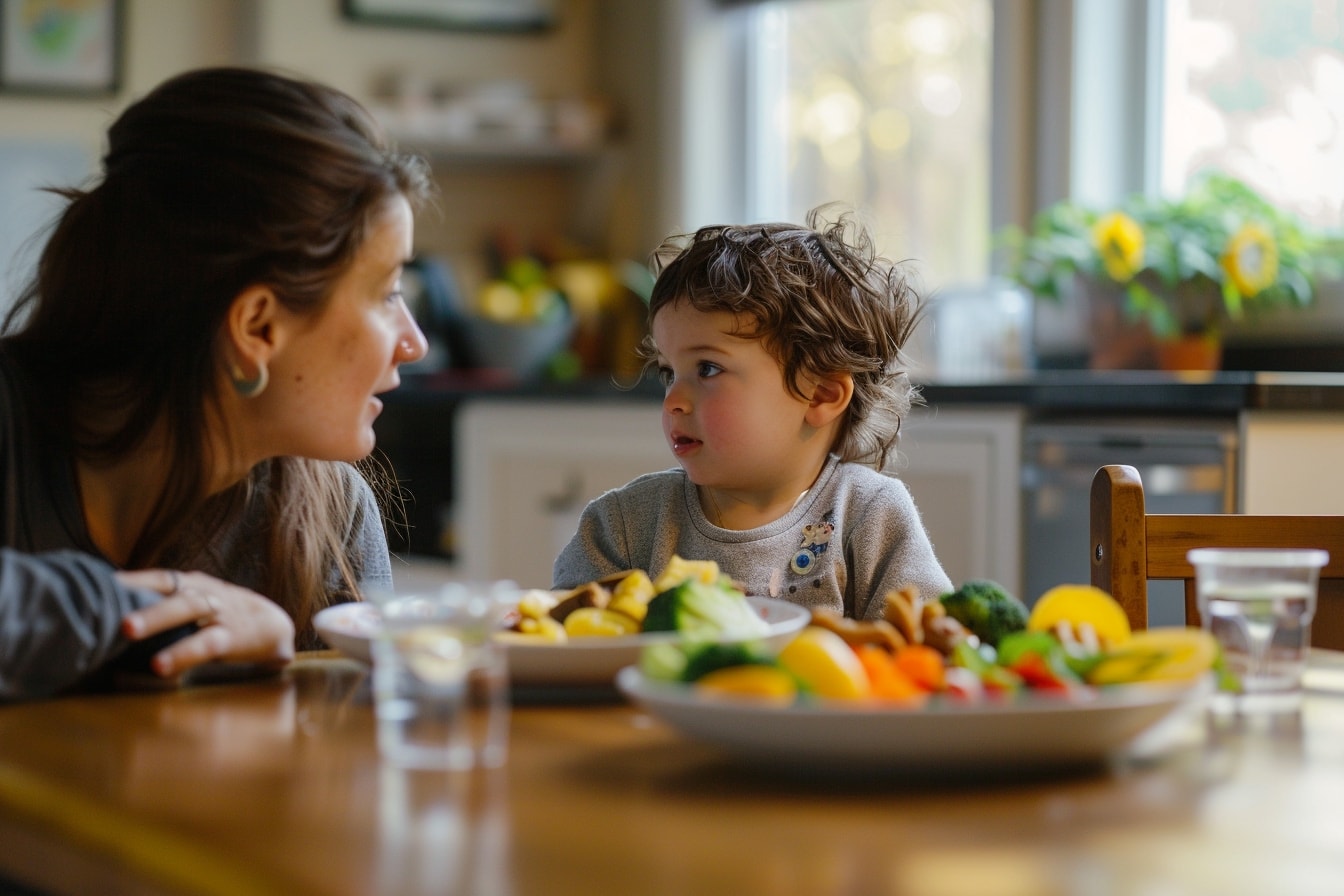Table of Contents
ToggleEmpowering Independence: Montessori and Baby-Led Feeding in Mealtime Mastery
Picture this: it’s a warm Caribbean evening, the scent of spices wafts through the air, and the table is set with vibrant dishes bursting with flavor. As parents, we strive to create not just a meal but an experience, one that nourishes both body and soul. Yet, in the hustle and bustle of everyday life, it’s easy to overlook the profound impact that mealtime can have on our little ones.
For many of us, mealtime is not just about food—it’s a moment of connection, of shared traditions, and of passing down cultural heritage. It’s where our children learn not just how to eat but how to navigate the world around them. And that’s why, as parents, we’re constantly seeking ways to make mealtime more than just a routine—it’s an opportunity for growth, independence, and joy.
Enter Montessori and baby-led feeding: two approaches that have been gaining traction in recent years for their emphasis on empowering children to take control of their own eating journey. But what exactly do these terms mean, and how can they be applied in the context of Caribbean culture?
In this article, we’ll embark on a journey to explore the intersection of Montessori philosophy and baby-led feeding, uncovering how these approaches can transform mealtime into a celebration of independence and cultural richness. So, pull up a chair, grab a plate, and let’s dive into the world of Montessori and baby-led feeding in mealtime mastery.
- How can Montessori principles revolutionize mealtime dynamics for parents and children alike?
- What does baby-led feeding entail, and how does it align with Caribbean traditions?
- How can we incorporate these approaches into our daily routines to foster independence and cultural celebration?
Join me as we uncover the secrets to creating mealtime magic that nourishes not just our bodies but our spirits, too.

Embracing Montessori Principles in Mealtime
Mealtime is more than just a time to eat; it’s a cornerstone of family life, a moment where connections are forged, and traditions are passed down. As parents, we strive to make mealtime a nurturing and enriching experience for our children, one that fosters independence and cultivates a love for healthy food. That’s where Montessori principles come into play, offering a unique approach to mealtime that empowers children to take an active role in their own nourishment.
At the heart of Montessori philosophy lies the belief in respecting the child as an individual with unique needs and abilities. This extends to mealtime, where children are encouraged to participate in every aspect of the dining experience, from setting the table to choosing their own food. By involving children in the preparation and serving of meals, we not only foster independence but also instill a sense of pride and ownership in their food choices.
One of the key principles of Montessori is the creation of a prepared environment that is conducive to learning and exploration. When it comes to mealtime, this means setting up a dining area that is inviting, accessible, and child-friendly. Child-sized tables and chairs allow children to sit comfortably and independently, while open shelves stocked with healthy snacks encourage them to make their own food choices.
But perhaps the most transformative aspect of Montessori mealtime is the emphasis on fostering a positive relationship with food. In a Montessori environment, mealtime is seen as a sensory experience, an opportunity for children to explore different tastes, textures, and flavors at their own pace. By allowing children to touch, smell, and taste their food freely, we not only promote healthy eating habits but also cultivate a lifelong appreciation for diverse cuisines and culinary traditions.
- How can we involve children in meal preparation and serving to promote independence?
- What are some practical ways to create a Montessori-inspired dining environment at home?
- How does the Montessori approach to mealtime contribute to a positive relationship with food?
So let’s embrace the wisdom of Maria Montessori and transform mealtime into a joyful and enriching experience that nourishes both body and soul.

Introducing Baby-Led Feeding
As parents, we’re constantly bombarded with conflicting advice on how to feed our children. From purees to pouches, it seems like everyone has an opinion on the best way to nourish our little ones. But what if I told you there’s a way to let your baby take the lead in their own feeding journey? Enter baby-led feeding, a revolutionary approach that empowers babies to explore food on their own terms.
So, what exactly is baby-led feeding? At its core, baby-led feeding is about allowing babies to feed themselves from the very beginning, skipping purees and spoon-feeding in favor of finger foods and self-feeding. By putting the power in the hands (or rather, mouths) of babies, we’re not only promoting independence but also laying the foundation for a healthy relationship with food.
But baby-led feeding isn’t just about what goes into your baby’s mouth—it’s also about fostering a positive mealtime environment that encourages exploration and curiosity. Instead of focusing solely on nutrition, baby-led feeding emphasizes the sensory experience of eating, allowing babies to touch, smell, and taste a variety of foods at their own pace.
One of the key benefits of baby-led feeding is its role in promoting self-regulation and autonomy. By allowing babies to decide how much and what to eat, we’re empowering them to listen to their own hunger and fullness cues, ultimately leading to healthier eating habits later in life. Plus, by introducing a wide variety of flavors and textures early on, we’re helping to expand their palates and instill a love for diverse cuisines.
- What are some examples of appropriate finger foods for babies?
- How can parents ensure that their baby is getting the nutrition they need with baby-led feeding?
- What are some common misconceptions about baby-led feeding, and how can they be addressed?
So let’s embrace the freedom and joy of baby-led feeding, allowing our little ones to explore the world of food on their own terms.

Navigating Challenges and Solutions
While the concept of Montessori and baby-led feeding may sound idyllic, the reality is that navigating this journey comes with its fair share of challenges. From mealtime messes to parental anxieties, there are many obstacles that parents may encounter along the way. But fear not, for with a little patience and perseverance, these challenges can be overcome.
One of the most common challenges parents face when implementing Montessori and baby-led feeding is the fear of choking. Watching your baby explore new foods can be anxiety-inducing, especially when it comes to foods that are traditionally considered choking hazards. However, it’s important to remember that babies have a natural gag reflex that helps protect them from choking. By offering age-appropriate foods and supervising mealtime closely, parents can minimize the risk of choking while still allowing their baby to explore and experiment with different textures.
Another challenge parents may encounter is resistance from family members or caregivers who are unfamiliar with the Montessori and baby-led feeding approach. Grandparents, in particular, may be accustomed to more traditional feeding methods and may express concern or skepticism about allowing babies to feed themselves. In these situations, it’s important for parents to communicate openly with their family members and educate them about the benefits of Montessori and baby-led feeding. By sharing research-backed information and involving them in the process, parents can help garner support and understanding from their loved ones.
Mealtime messes are yet another challenge that parents may face when practicing Montessori and baby-led feeding. Let’s face it—babies are messy eaters, and allowing them to explore food independently can result in spills, stains, and sticky fingers. However, instead of viewing messes as a nuisance, parents can embrace them as an integral part of the learning process. Providing babies with a safe and comfortable space to explore food can help minimize messes, while involving them in the cleanup process can instill a sense of responsibility and independence.
- How can parents overcome their fear of choking when practicing baby-led feeding?
- What strategies can parents use to educate family members about the benefits of Montessori and baby-led feeding?
- How can parents create a mealtime environment that minimizes messes while still allowing babies to explore food independently?
So let’s face these challenges head-on, armed with patience, knowledge, and a willingness to embrace the messy, beautiful journey of Montessori and baby-led feeding.

Trends in Child Development and Nutrition
As parents, we’re constantly bombarded with new information and trends in child development and nutrition. From the latest research findings to ever-changing dietary guidelines, it can be overwhelming to keep up with it all. But amidst the noise, there are some key trends emerging that are reshaping the way we approach feeding and nurturing our children.
One trend that has gained traction in recent years is the focus on fostering independence and autonomy in children from a young age. Research has shown that allowing children to take control of their own feeding journey can have profound effects on their development and long-term eating habits. By embracing approaches like Montessori and baby-led feeding, parents are not only empowering their children but also laying the foundation for a healthy relationship with food.
Another trend that is shaping the way we feed our children is the increasing recognition of the role that cultural influences play in dietary practices. As our world becomes more interconnected, families are embracing their cultural heritage and incorporating traditional foods and cooking methods into their mealtime routines. This celebration of diversity not only exposes children to a wide variety of flavors and cuisines but also instills a sense of pride and connection to their cultural identity.
But perhaps the most significant trend in child development and nutrition is the growing understanding of the importance of early experiences in shaping lifelong health outcomes. Research has shown that the first few years of life are a critical period for brain development, and nutrition plays a key role in supporting this growth and development. By providing children with nutritious, balanced meals from an early age, parents can set them on the path to a lifetime of health and wellness.
- How can parents incorporate cultural traditions into their mealtime routines to promote diversity and connection?
- What role does early childhood nutrition play in shaping long-term health outcomes?
- How can parents stay informed about the latest trends and research findings in child development and nutrition?
So let’s embrace these trends and insights, using them to guide us as we navigate the ever-changing landscape of child development and nutrition.

Practical Implementation and Engagement
So, you’re sold on the idea of incorporating Montessori and baby-led feeding principles into your mealtime routine—but where do you start? Fear not, dear reader, for I’m here to guide you through the practical steps of bringing these concepts to life in your own home. Get ready to roll up your sleeves and embark on a journey of discovery and deliciousness!
First things first: let’s talk about creating a Montessori-inspired dining environment. Start by setting up a designated eating area that is accessible to your little one. Child-sized tables and chairs are a must-have, allowing your child to sit comfortably and independently at mealtime. Consider investing in some open shelves or low cabinets where your child can easily access plates, utensils, and healthy snacks.
Next, it’s time to stock up on some baby-friendly finger foods. Think soft fruits and vegetables, whole grain bread, and cooked proteins like chicken or tofu. Avoid foods that pose a choking hazard, such as nuts, popcorn, and raw carrots. Remember, the goal is to offer a variety of textures and flavors for your baby to explore at their own pace.
When it comes to mealtime itself, take a hands-off approach and let your baby take the lead. Offer a selection of foods and let them choose what to eat and how much. Resist the urge to intervene or coax them into eating—trust that they know their own hunger and fullness cues better than anyone else.
But mealtime isn’t just about food—it’s also about engagement and connection. Use mealtime as an opportunity to bond with your baby, chatting and laughing together as you explore new flavors and textures. Encourage sensory exploration by involving your baby in the cooking process, letting them smell, touch, and taste ingredients as you prepare meals together.
- What are some age-appropriate activities that parents can incorporate into mealtime to promote engagement and learning?
- How can parents encourage independence and autonomy in their children during mealtime?
- What are some resources or tools that parents can use to support their journey towards Montessori and baby-led feeding?
So roll up your sleeves, gather your ingredients, and get ready to embark on a delicious adventure in Montessori and baby-led feeding. Your little one’s taste buds—and independence—will thank you!
As we come to the end of our culinary journey through the world of Montessori and baby-led feeding, let’s take a moment to reflect on the lessons we’ve learned and the transformations we’ve experienced.
Mealtime is more than just a moment to satisfy hunger—it’s an opportunity for connection, exploration, and growth. By embracing the principles of Montessori and baby-led feeding, we’ve empowered our children to take an active role in their own nourishment, fostering independence and confidence along the way.
But the benefits of Montessori and baby-led feeding extend far beyond the dinner table. By celebrating cultural diversity and honoring our culinary traditions, we’ve enriched our family’s mealtime experience and instilled a sense of pride and connection in our children.
As we look to the future, let’s continue to embrace the wisdom of Maria Montessori and the principles of baby-led feeding, using them to guide us as we navigate the ups and downs of parenting. Let’s create mealtime magic that nourishes not just our bodies but our spirits, too.
So here’s to the messy, beautiful journey of Montessori and baby-led feeding—a journey filled with laughter, love, and delicious discoveries. May your plates be full, your hearts be light, and your bellies be satisfied. Bon appétit!
Want to take your knowledge to the next level? Check out these must-read articles:
- Creating a Montessori-inspired Baby Registry: Practical and Purposeful Items
- Montessori and Baby Brain Development: Nurturing Cognitive Skills Early On
Organize your baby’s wardrobe with our baby clothes closet organizer products! Our organizers are designed specifically for baby clothes. Get your baby’s clothes neat and tidy with our selection of organizers – shop now!
Step into Sue Brown's World of Baby Care, where you'll find a treasure trove of knowledge and wisdom waiting to be explored. Sue's dedication to providing accurate and up-to-date information on baby care shines through in every article, blog post, and resource she shares. From newborn essentials to sleep training tips, breastfeeding advice to nurturing your baby's development, Sue covers a wide range of topics that are essential for every parent to know. Her warm and compassionate approach creates a sense of community and reassurance, making her website a safe haven for parents seeking guidance and support. Let Sue Brown be your partner in this beautiful journey of parenthood, as she empowers you to create a loving, nurturing, and thriving environment for your little one.
- Indoor Air Quality for Infant Respiratory Health - October 20, 2025
- Positive Discipline Foundations: Setting the Stage From Infancy - October 18, 2025
- 2025’s Most Innovative Baby Products Worth the Investment - October 16, 2025



